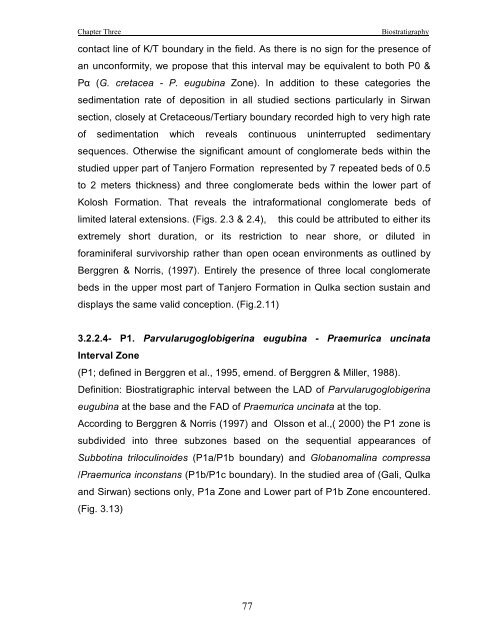biostratigraphy and paleoecology of cretaceous/tertiary boundary in ...
biostratigraphy and paleoecology of cretaceous/tertiary boundary in ...
biostratigraphy and paleoecology of cretaceous/tertiary boundary in ...
You also want an ePaper? Increase the reach of your titles
YUMPU automatically turns print PDFs into web optimized ePapers that Google loves.
Chapter Three Biostratigraphy<br />
contact l<strong>in</strong>e <strong>of</strong> K/T <strong>boundary</strong> <strong>in</strong> the field. As there is no sign for the presence <strong>of</strong><br />
an unconformity, we propose that this <strong>in</strong>terval may be equivalent to both P0 &<br />
Pá (G. cretacea - P. eugub<strong>in</strong>a Zone). In addition to these categories the<br />
sedimentation rate <strong>of</strong> deposition <strong>in</strong> all studied sections particularly <strong>in</strong> Sirwan<br />
section, closely at Cretaceous/Tertiary <strong>boundary</strong> recorded high to very high rate<br />
<strong>of</strong> sedimentation which reveals cont<strong>in</strong>uous un<strong>in</strong>terrupted sedimentary<br />
sequences. Otherwise the significant amount <strong>of</strong> conglomerate beds with<strong>in</strong> the<br />
studied upper part <strong>of</strong> Tanjero Formation represented by 7 repeated beds <strong>of</strong> 0.5<br />
to 2 meters thickness) <strong>and</strong> three conglomerate beds with<strong>in</strong> the lower part <strong>of</strong><br />
Kolosh Formation. That reveals the <strong>in</strong>traformational conglomerate beds <strong>of</strong><br />
limited lateral extensions. (Figs. 2.3 & 2.4), this could be attributed to either its<br />
extremely short duration, or its restriction to near shore, or diluted <strong>in</strong><br />
foram<strong>in</strong>iferal survivorship rather than open ocean environments as outl<strong>in</strong>ed by<br />
Berggren & Norris, (1997). Entirely the presence <strong>of</strong> three local conglomerate<br />
beds <strong>in</strong> the upper most part <strong>of</strong> Tanjero Formation <strong>in</strong> Qulka section susta<strong>in</strong> <strong>and</strong><br />
displays the same valid conception. (Fig.2.11)<br />
3.2.2.4- P1. Parvularugoglobiger<strong>in</strong>a eugub<strong>in</strong>a - Praemurica unc<strong>in</strong>ata<br />
Interval Zone<br />
(P1; def<strong>in</strong>ed <strong>in</strong> Berggren et al., 1995, emend. <strong>of</strong> Berggren & Miller, 1988).<br />
Def<strong>in</strong>ition: Biostratigraphic <strong>in</strong>terval between the LAD <strong>of</strong> Parvularugoglobiger<strong>in</strong>a<br />
eugub<strong>in</strong>a at the base <strong>and</strong> the FAD <strong>of</strong> Praemurica unc<strong>in</strong>ata at the top.<br />
Accord<strong>in</strong>g to Berggren & Norris (1997) <strong>and</strong> Olsson et al.,( 2000) the P1 zone is<br />
subdivided <strong>in</strong>to three subzones based on the sequential appearances <strong>of</strong><br />
Subbot<strong>in</strong>a trilocul<strong>in</strong>oides (P1a/P1b <strong>boundary</strong>) <strong>and</strong> Globanomal<strong>in</strong>a compressa<br />
/Praemurica <strong>in</strong>constans (P1b/P1c <strong>boundary</strong>). In the studied area <strong>of</strong> (Gali, Qulka<br />
<strong>and</strong> Sirwan) sections only, P1a Zone <strong>and</strong> Lower part <strong>of</strong> P1b Zone encountered.<br />
(Fig. 3.13)<br />
77

















